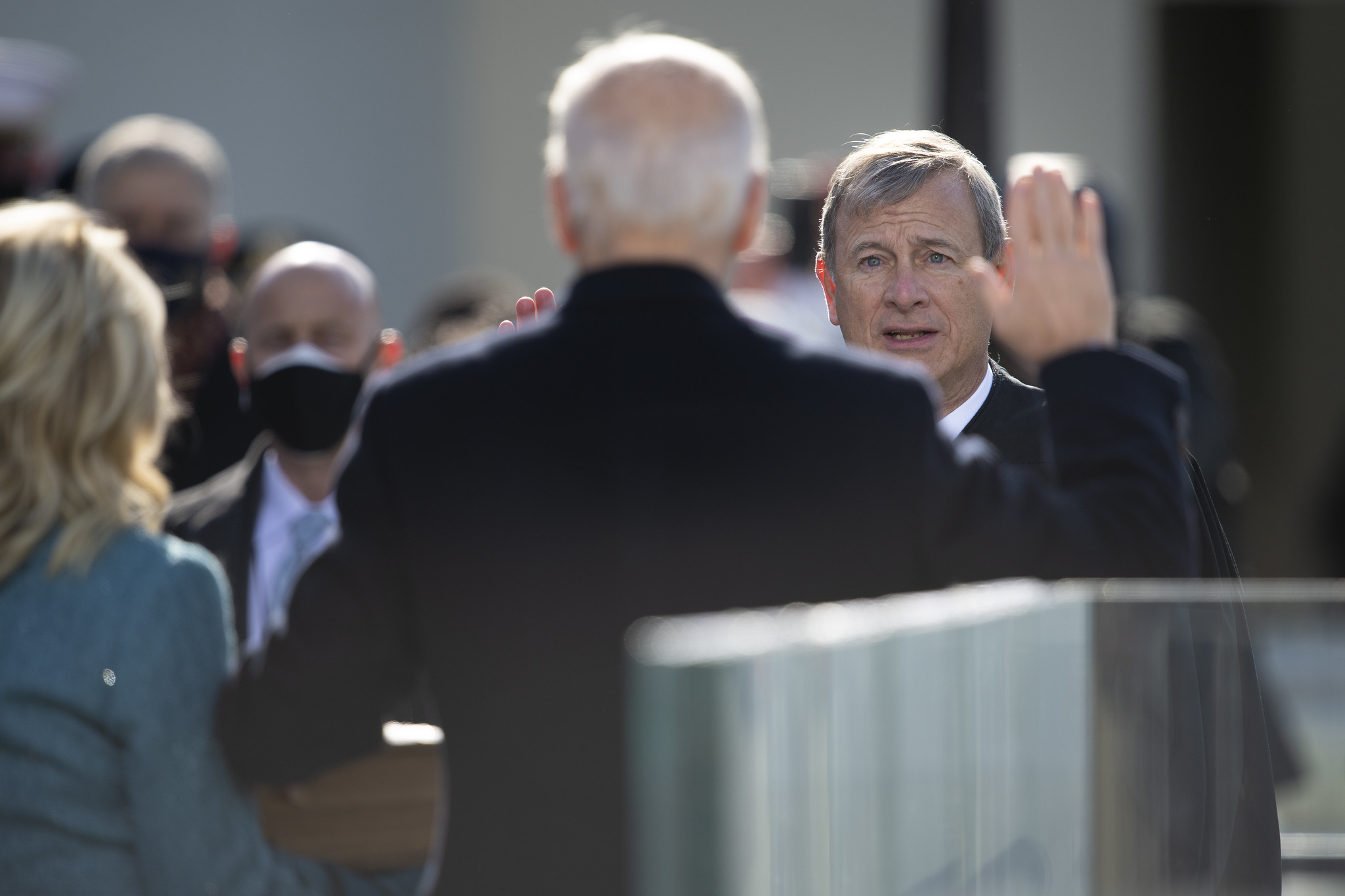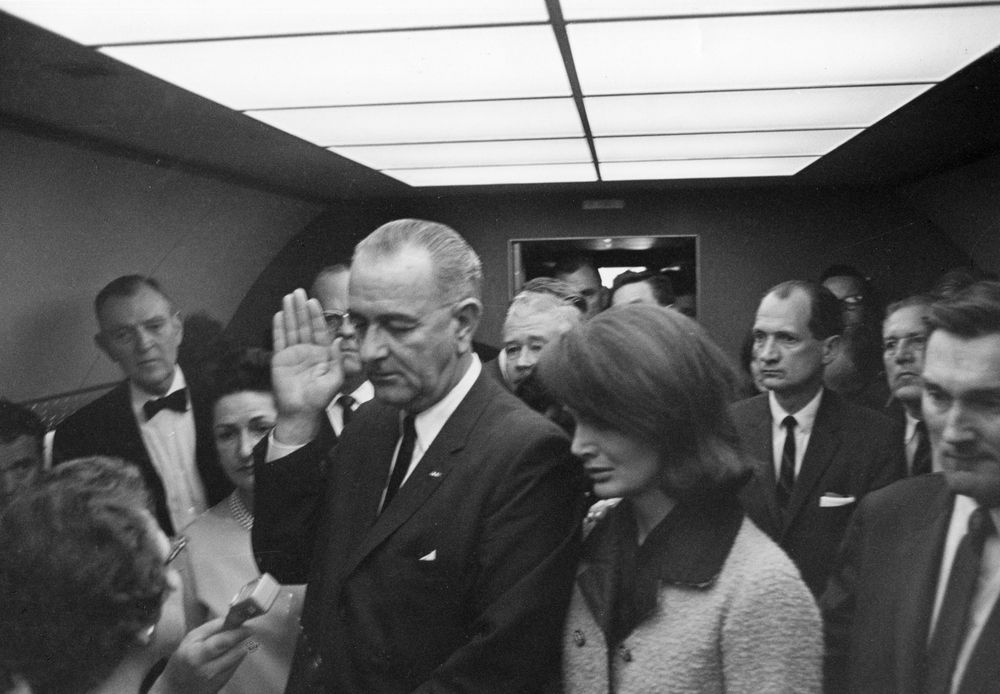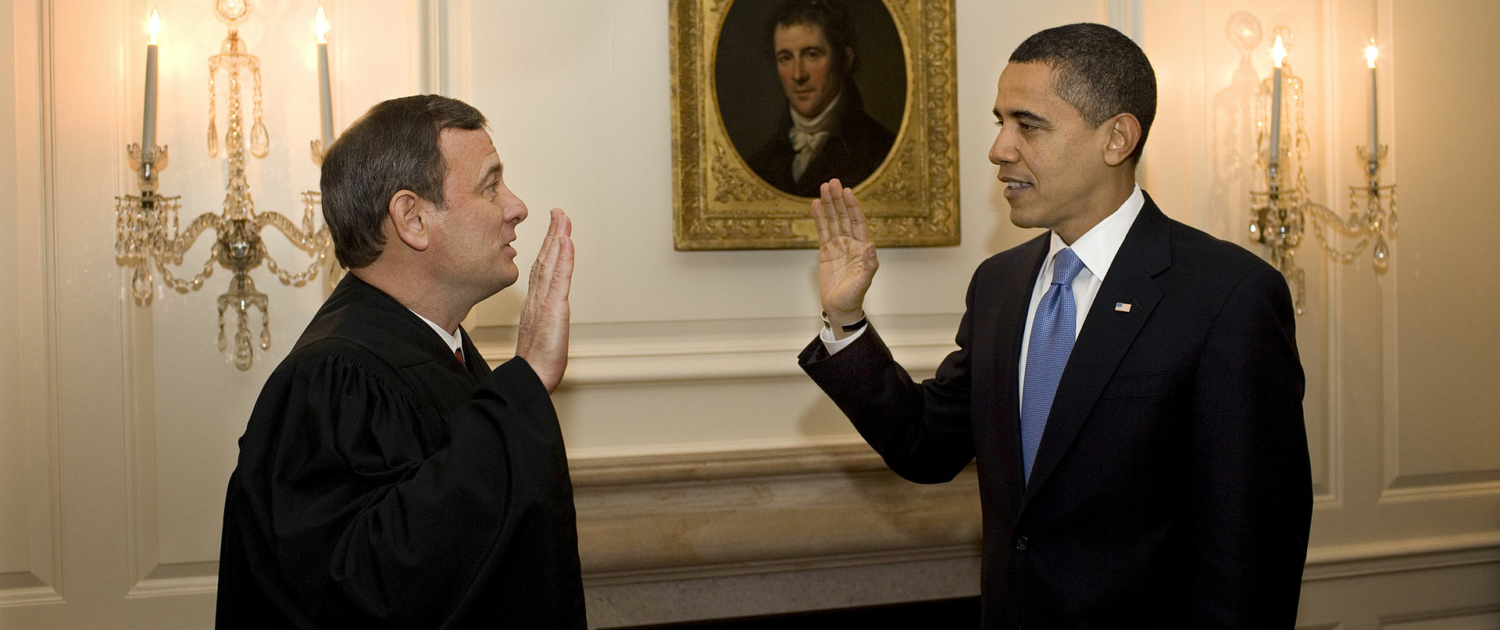Pop Civ is a series developed by the John Marshall Center for Constitutional History & Civics at the VMHC. By connecting current events and popular culture with historical events, these articles and discussion questions provide classrooms and the general public with valuable context to consider our civic legacy. View all Pop Civ articles.
The Peaceful Transfer of Power: Oaths and Inaugurations

Chief Justice John G. Roberts Jr. swears President Joe Biden into office during the 59th Presidential Inauguration ceremony in Washington, Jan. 20, 2021.
Credit: Department of Defense/Navy Petty Officer 1st Class Carlos M. Vazquez II
At noon on January 20, 2021, Joseph Biden was sworn in as President of the United States. Chief Justice John Roberts, in keeping with longstanding tradition, administered the oath of office, while Justice Sonia Sotomayor swore Kamala Harris in as Vice President. In the midst of a pandemic and on the heels of a mob storming the U.S. Capitol on January 6 of the same year, it was announced that Biden's inauguration day would be “reimagined” from previous ones. Shortly before the inauguration, President Trump Tweeted that he wouldn't attend the event. While noteworthy, Trump wasn't the first outgoing president to decline to attend the inauguration of a successor. A look at three inaugurations – the first each of Thomas Jefferson, Lyndon Johnson, and Barack Obama – reveals that while inaugurations rely a little on the Constitution and heavily on symbolic and strategic traditions, each one is slightly retooled to ensure continuity of government and the peaceful transfer of power.
THOMAS JEFFERSON’S INAUGURATION, 1801
On March 4, 1801, outgoing President John Adams left the White House and D.C. before dawn. His political opponent, Thomas Jefferson, would be inaugurated as third President of the United States at noon. The outgoing President wanted to put as much distance between himself and the new Administration as he could.
At President-Elect Jefferson’s request, the new Chief Justice John Marshall would be administering the oath of office. Marshall was a Federalist like Adams. He admired George Washington and shared much of the same outlook on the U.S. Constitution as Alexander Hamilton. Marshall had served in Congress for part of a term, only to be plucked out by President Adams to serve as Secretary of State—a position that he continued to hold for a time even after Adams appointed him to the Supreme Court. Everything in Marshall’s background—other than being a fellow Virginian—put Marshall at odds with Jefferson.
Incoming President Jefferson was the leader of the political party, the Democratic-Republicans, born during the 1790s in opposition to Hamilton’s financial plans, Washington’s foreign policy, and other actions of the Washington and Adams administrations. The transfer of power from Adams to Jefferson on March 4, 1801, put the new experiment in American self-government to the test. Its peaceful accomplishment was a crucial turning point in American history, for it easily could have been the end point.
Jefferson’s choice of Marshall to administer the oath complemented the conciliatory rhetoric of his inaugural address.
“Every difference of opinion is not a difference of principle,” Jefferson said, “we are all Republicans, we are all Federalists.”
Jefferson’s pick of someone the public strongly associated with the outgoing administration might be analogized in today’s context to President-Elect Biden asking Justice Gorsuch, Kavanaugh, or Barrett to administer the oath of office to him.
This letter written by John Marshall to Charles Cotesworth Pinckney captures the drama of the historical moment. Marshall and Pinckney were both Federalists. A few years earlier, they had served together in attempting to negotiate with France to stop American shipping from being attacked. That mission ended with what has become known as the XYZ Affair, the letters standing in for the names of three people who tried to solicit bribes from the American delegation in France. More recently, Pinckney was a failed candidate for vice-president in the election of 1800.
At the opening of the letter, Marshall writes of his intent to administer the oath to Jefferson at noon that day, March 4. He takes a reflective tone as he mentions his surprise at individuals he believes will attend the ceremony and outlines his worries for Jefferson’s administration.
Marshall’s writing resumes with the entry “4 OClock,” indicating that time has elapsed, and that the oath had been administered. His modest paise of Jefferson’s inaugural address is consistent with his remarks about Jefferson earlier that day—while he has no love of the man’s political party, he seems to respect Jefferson’s attempts to reconcile the new nation’s divisions.
FAQs: What Does the Constitution Say About Presidential Inaugurations?
Q: What is an oath of office?
A: An oath is a formal and solemn promise. It is a pledge made on one’s personal honor and with God as one’s witness. A person who takes an oath swears to do what he or she promises. The Constitution provides the option of an oath, or a similarly solemn affirmation. The difference between an oath and affirmation is that an affirmation does not involve a religious element.
Q: How is the Presidential oath of office different from other oaths?
A: The presidential oath of office is the only such oath whose precise words are prescribed by the Constitution itself. Article II, Section 1, states:
“Before he enter on the Execution of his Office, he shall take the following Oath or Affirmation: ‘I do solemnly swear (or affirm) that I will faithfully execute the Office of President of the United States, and will to the best of my Ability, preserve, protect and defend the Constitution of the United States.’”
Note: while the Constitution continuously refers to the President as male, both men and women are eligible to be elected president.
Q: Who else takes oaths of office?
A: The Constitution requires federal and state officeholders to take an oath. Unlike the presidential oath, the Constitution does not supply the precise words. Article VI, Clause 3 states:
“The Senators and Representatives before mentioned, and the Members of the several State Legislatures, and all executive and judicial Officers, both of the United States and of the several States, shall be bound by Oath or Affirmation, to support this Constitution; but no religious Test shall ever be required as a Qualification to any Office or public Trust under the United States.”
While they may not be specifically outlined in the U.S. Constitution, oaths of office or service are also found in other professions. Doctors commit to do no harm to their patients, lawyers swear to support the Constitution, and police officers pledge to protect and serve their communities.
Q: Why does the President take the Oath of Office on January 20?
A: Until the 1930s, the new president would take the oath of office on March 4 of the year following the election. Over time, people came to think that this was too long of a gap. The Twentieth Amendment, ratified in 1933, set the date of the presidential transition as January 20th The expression, lame-duck session of Congress, refers to the time period between the election and inauguration day.
Section 1 of the 20th Amendment states:
“The terms of the President and Vice President shall end at noon on the 20th day of January … and the terms of their successors shall then begin.”
Q: What else does the Constitution say about the inauguration and Presidential transitions?
A: That’s about it! Many other traditions have grown up around the transition. But these are not set forth in the Constitution.
Securing the Continuity of Government: Lyndon B. Johnson's Oath, 1963

President Lyndon B. Johnson takes the oath of office on Air Force One at Love Field in Dallas, Texas, following the assassination of President John F. Kennedy. Left to right: media liaison, Jack Valenti (on edge of frame); Judge Sarah T. Hughes (administering oath); Representative Albert Thomas (Texas); First Lady Lady Bird Johnson; Dallas Police Chief, Jesse Curry (face partially hidden by President Johnson’s raised hand); President Johnson; Representative Homer Thornberry (Texas); former first lady, Jacqueline Kennedy; Representative Jack Brooks (Texas); Deputy Director of Public Affairs for the Peace Corps, Bill Moyers (in back); President Kennedy’s physician, Admiral Dr. George G. Burkley; Special Assistant to President Kennedy, Kenneth P. O’Donnell.
Credit: Cecil Stoughton. White House Photographs. John F. Kennedy Presidential Library and Museum, Boston.
During national emergencies, the honoring of tradition is less important than ensuring the transfer of power. After President John Kennedy’s 1963 assassination in Dallas, Vice President Lyndon Johnson needed to take the oath of office as swiftly as possible. Rather than wait until the Chief Justice could be brought to Dallas, it was recommended that a federal judge administer the oath. From Johnson came the directive: “Get me Sarah Hughes.” Sarah Tilman Hughes, at that point only two years into her tenure as a federal district court judge in northern Texas, was a personal friend of Johnson and a supporter of the Democratic Party. She quickly made her way to Love Field in Dallas, where Air Force One was waiting with Johnson aboard.
The ceremony that followed included several historical firsts. Hughes would become the first (and to date, only) woman to administer the presidential oath of office. It was also the first and only time that the oath had been administered aboard an airplane. And rather than using a Bible, the traditional choice for all previous Presidents, Johnson selected a Missal from a table in Kennedy’s Air Force One bedroom as the text upon which he swore his oath.
Chief Justices Make Mistakes, Too! Barack Obama's Inauguration, 2009

To avoid any constitutional problems, Chief Justice John Roberts administers the oath of office a second time to Barack Obama in the Map Room of the White House on Wednesday, January 21, 2009.
Credit: Pete Souza, White House
Anyone who has spoken in public has likely felt worried that they might slip up, forget a part of their speech, or mispronounce a word.
Evidently, even chief justices are not immune from that pressure. At President Barack Obama’s first inauguration in 2009, Chief Justice John Roberts accidentally transposed two words in the oath. Roberts prompted the president to repeat “that I will execute the Office of President of the United States faithfully,” although the language in the Constitution explicitly requires the President to say, “I do solemnly swear that I will faithfully execute the Office of President of the United States …”
Although the error was minor, concerns immediately arose that perhaps President Obama’s oath would be invalidated. To rectify the problem, Roberts visited the White House the following day to repeat the ceremony. Thankfully, both the Chief Justice and President were more silver-tongued in their delivery that day, and the oath was successfully administered.
